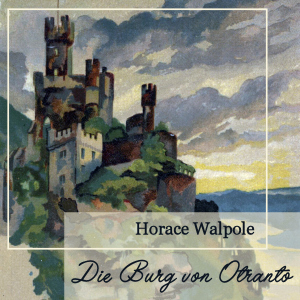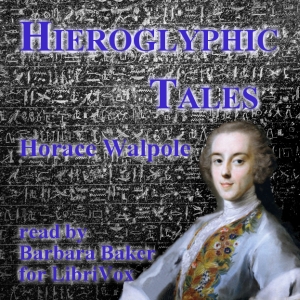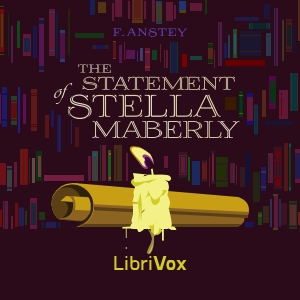A Sicilian Romance is a Gothic novel by Ann Radcliffe. It was her second published work, and was first published anonymously in 1790. The plot concerns the turbulent history of the fallen aristocrats of the house of Mazzini, on the northern shore of Sicily, as related by a tourist who becomes intrigued by the stories of a monk he meets in the ruins of their doomed castle.The introduction to the 'Worlds Classics' edition notes that in this novel "Ann Radcliffe began to forge the unique mixture of the psychology of terror and poetic description that would make her the great exemplar of the Gothic novel, and the idol of the Romantics". The novel explores the "cavernous landscapes and labyrinthine passages of Sicily's castles and convents to reveal the shameful secrets of its all-powerful aristocracy" (Summary from Wikipedia)
16 episodes
The Marble Faun is Hawthorne's most unusual romance. Writing on the eve of the American Civil War, Hawthorne set his story in a fantastical Italy. The romance mixes elements of a fable, pastoral, Gothic novel, and travel guide. In the spring of 1858, Hawthorne was inspired to write his romance when he saw the Faun of Praxiteles in a Roman sculpture gallery. The theme, characteristic of Hawthorne, is guilt and the Fall of Man. The four main characters are Miriam, a beautiful painter who is compared to Eve, Beatrice Cenci, Lady Macbeth, Judith, and Cleopatra, and is being pursued by a mysterious, threatening Model; Hilda, an innocent copyist who is compared to the Virgin Mary; Kenyon, a sculptor, who represents rationalist humanism; and Donatello, the Count of Monti Beni, who is compared to Adam, resembles the Faun of Praxiteles, and is probably only half human. (Summary by Wikipedia)
50 episodes
The love story between a nobleman and a beautiful lady whom he meets in church leads both of them to unexpected places, as many people would not put up with their love. This novel is considered to be one of the best Gothic novels ever written, by one of the first (and best) writers of the genre. How does an "indecent" love story become a Gothic tale? What is the outcome of this love story? If you want to know, read this book. (Summary by Stav Nisser)
NOTE: There was no chapter 30 in the edition used in this project. The chapter numbers skip from 29 to 31. Chapter 5 was added on 28/Aug/2020.
40 episodes

Matthew Gregory Lewis's The Monk: A Romance is a story of frustrated and unrequited desire between mentor and pupil mixed with elements of the supernatural. It includes several subplots: rape, torture and incest. It is the old story of the forces of good versus the forces of evil, except that in this one evil comes out ahead.
When The Monk was first published in 1795, it was received well by readers and reviewers causing a second edition to be printed the following year. But by the third year, there began a growing criticism of the book and of Lewis mostly on the basis of immorality. In fact, the book caused such a scandal that Lewis published another version complete with redactions and entire rewrites so as to remove the shame it had brought upon his family and the political institution of which he was a part.
The Monk finds itself straddling the genres of Gothicism and Decadence, and includes elements of Romanticism. Lewis also chose to blend the roles of gender in this work--particularly in the character of Rosario/Matilda. The sexual tension between Ambrosio and this character--along with the eventual revelation of true identity--are an exposé on the topic of same-sex love and makes this work an early contribution to LGBT literature.
In spite of the mountains of criticism against the book, it remained a best seller well into the 19th century. The version I will read for you is the unexpurgated version including all of the “scandal and immorality” of the original. (Introduction by James K. White)
23 episodes
Julian LeVallon, born and raised alone in the Jura Mountains, is referred to psychiatrist Dr. Edward Fillery for care in London. But is LeVallon merely a schizophrenic with a secondary personality, "N.H." (non-human), or is he really an Elemental Being, a "bright messenger" who brings, perhaps, a new age of human evolution? And if so, is the human race ready for a major step forward? [Summary by Mark Nelson]
27 episodes
A young man of good family with a long distinguished military tradition indicates that he will not follow his ancestors' path into the army. Dire results ensue. Benjamin Britten in 1970 wrote an opera based on this story. ( Summary by david wales)
4 episodes

Manfred, der Fürst von Otranto ist besorgt um die Zukunft seines Hauses und will deshalb seinen Sohn so bald als möglich mit Isabelle verheiraten, die durch ihren Vater Friedrich selbst Ansprüche auf Otranto machen kann. Friedrich ist auf dem Kreuzzug in Gefangenschaft geraten und gilt als tot.
Auf dem Weg zur Trauung erleidet Manfreds Sohn einen tödlichen Unfall - er wird von einem riesigen Helm erschlagen. Kurz darauf erscheint eine riesige Gestalt in der Burg und löst Panik unter den Bediensteten aus. Doch Manfred hat ganz andere Sorgen. Da sein Sohn nun tot ist, will er selbst die schöne Isabelle heiraten, aber dazu muss er seine Gemahlin Hippolite überreden, in eine Scheidung einzuwilligen. Außerdem ist da noch Theodor, der sich unschuldig Manfreds Zorn zuzieht, durch die Fürsprache Mathildens, Manfreds Tochter, gerettet wird und später Isabelle bei deren Flucht vor Manfreds Nachstellungen hilft.
Die Situation spitzt sich zu, als 500 Bewaffnete vor der Burg erscheinen, die ein riesiges Schwert mit sich führen und im Namen Friedrichs die Herausgabe von Isabelle fordern. Auch taucht die riesige Gestalt wieder in der Burg auf und man munkelt allenthalben von einer alten Prophezeiung, die Burg und Herrschaft Otranto solle dem Geschlecht Manfreds entwendet werden, wenn dem wirklichen Besitzer seine Behausung zu enge würde.
Die Burg von Otranto gilt als erste Gothic Novel und damit als Wegbereiter für Dracula, Frankenstein und co. Die anonyme deutsche Übersetzung von 1810 ist in einer auch damals schon altertümlichen Sprache gehalten. (Zusammenfassung von Hokuspokus)
11 episodes
Famous for introducing the character of the vampire Count Dracula, the novel tells the story of Dracula's attempt to move from Transylvania to England so he may find new blood and spread the undead curse, and the battle between Dracula and a small group of men and women led by Professor Abraham Van Helsing. Although Stoker did not invent the vampire, he defined its modern form, and the novel has spawned numerous theatrical, film and television interpretations. - Summary by wikipedia
27 episodes
Ubicada en la Europa del siglo XVIII y en plena efervescencia científica, el capitán de un barco ballenero escribe a su hermana Margaret su encuentro con el joven estudiante de filosofía natural Víctor Frankenstein. Dicho hombre ha descubierto el secreto para dar vida a la materia muerta y ha creado un ser vivo y, sin medir las consciencias de sus actos, ha empleado para ello partes de otros seres humanos muertos. El resultado es monstruoso y, a partir de aquí, se inicia una confrontación llevada hasta su extremo. Un constante cuestionamiento filosófico y moral del hombre contra su creador y viceversa que conduce la historia hasta su trágico final. Además de una obra maestra de la literatura, se trata de una fantástica novela que muestra los peligros de jugar a ser Dios con aquello que no se conoce y no se es capaz de puede controlar. - Summary by Phileas Fogg
28 episodes
Surreal and satirical, these stories by the eighteenth century man of letters, Whig politician, art historian and antiquarian are '"...mere whimsical trifles, written chiefly for private entertainment, and for private amusement... an attempt to vary the stale and beaten class of stories and novels, which, though works of invention, are almost always devoid of imagination...." Horace Walpole - Summary by barbara2
8 episodes
If you stumble upon the elixir of life, which provides you with eternal life, youth and health, then it's rather a bad idea to spoil this great gift by signing a pact with the devil on top of it to receive great financial fortune as well. Auriol Darcy, the protagonist of our story, has in fact made this mistake, but soon finds out that the price to pay is much too high to bear. And getting out of a pact with the devil is never easy.William Harrison Ainsworth's novel is divided into three parts and the final part provides quite a surprise twist ending, which will not be revealed here. The surrealistic plot and setting and especially the psychological elements give this novel quite a modern touch, considering it's been written as early as 1844. The colourful characterization of some shady people from the lower classes of society lend a humouristic touch to the story which provides a nice contrast to the otherwise gloomy gothic atmosphere of the main plot. - Summary by Sonia
24 episodes
"The Man-Wolf" is a 38,000 word novella that appears in the English language collection of short stories entitled, The Man-Wolf and Other Tales. The other tales in that collection were not recorded for this project. The Man-Wolf is a gothic tale of lycanthropy authored by the French writing duo of Emile Erckmann and Alexandre Chatrian. Obviously this is an early version of the popular werewolf narrative, but it certainly is not the first. In fact, the lycanthropy mythology go back at least as far as the first century A. D. Listen and compare what you know of the modern-day werewolf story with what Erckmann and Chatrian imagined. - Summary by James K. White
14 episodes
Wagner is a poor, lonely old shepherd living on the edge of the Black Forest. In a devil's pact he gains youth and wealth for the price of transforming into a ravenous wolf once a month. This book contains everything from murder, kidnap, robbery, sadistic nuns and lust to war in sixteenth century Italy. Originally published in a serialised form, this penny dreadful is definitely not a piece of fine literature, but is hopefully entertaining.
This book contains racial and other prejudices that were once commonplace. They are retained, as originally written in this recording, because to do otherwise would be to deny they existed. - Summary by clarinetcarrot
71 episodes
Victoria de Loredani lives the life of a fairy tale princess in Venice. She has everything one might desire and more, until the sinister Count Ardolph enters her world. The Count carries off Victoria's mother in an elopement, and sets off a series of dramatic events that begin to unhinge Victoria's life entirely. Passion, brutality, and murder begin to dominate the separated worlds of Victoria and her brother Leonardo. - Summary by Carolin
33 episodes

Written by Gothic writer Matthew Lewis, whose novel The Monk is one of the most enduring Gothic works from the eighteenth century, The Castle Spectre is one of Lewis' earliest forays into drama, and a strong indication of his talents as a controversial and frightening entertainer. Set in medieval Conway, Wales, the play is filled with every delicious Gothic trope imaginable: a menacing castle, a villainous nobleman hiding terrible secrets, a virginal damsel in distress, an heroic lover trying to save her, several comedic supporting characters, and, yes, the presence of a ghost. Popular when it was first staged at the Theatre Royal, Drury Lane in 1797, The Castle Spectre is an irresistible confection that deftly mixes light farce and romance with dark tragedy, keeping you on the edge of your seat right up to the final epilogue. Summary by Tomas PeterCast List:Osmond: NemoReginald: David OlsonPercy: Tomas PeterFather Philip: Son of the ExilesMotley: ToddHWKenric: Patrick SavilleSaib: Sandra SchmitHassan: KHandMuley: Kieren MettsAlaric: RecordingPersonAllan: Craig FranklinEdric: Eva DavisHarold: Tony AddisonChorus: Alan MapstoneAngela: Leanne YauAlice: SoniaEvelina: KalyndaNarrator: Chuck WilliamsonEditor: ToddHW
5 episodes
¡Qué puedo decir sobre los cuentos de Poe que no se sepa ya! Reconocido mundialmente como maestro del relato corto y cuentos de terror, esta recopilación reúne parte de sus mejores relatos. - Summary by Montse González
21 episodes
"Le Portrait de Dorian Gray" fut écrit et publié par Oscar Wilde en 1890 et révisé en 1891. Touchant des sujets philosophiques et fantastiques, Wilde révèle le côté décadent de l'époque Victorienne, touchant même au Satanisme, avec le jeune Dorian Gray, qui rend son âme à un portrait de lui-même, afin de ne jamais vieillir. En effet, Dorian reste toujours jeune, mais peu à peu, il perd son innocence et sa compassion. La beauté de sa figure ne change pas, mais le portrait commence à montrer l'aspect hideux qui a enveloppé son âme. Horrifié, il cache ce portrait, qui chaque jour, devient de plus en plus monstrueux. L'auteur introduit des questions de moralité, beauté, jeunesse, et l'hédonisme. Plusieurs de critiques contemporains de Wilde ont jugé son roman "répugnant." Cependant, ce titre reste jusqu'à nos jours une des oeuvres plus lues et plus aimées de la littérature anglaise. Cette traduction fut écrite par Eugène Tardieu, et publiée en 1920. - Summary by Linda Olsen Fitak
21 episodes
Novela de suspense, misterio...terror. Nos lleva a reflexionar sobre las dos caras de la vida y también del ser humano: El bien y el mal.
El doctor Enrique Jekyll crea una fórmula, un bebedizo, que al ser ingerida le metamorfosea en el ser más cruel y perverso imaginable: Eduardo Hyde. - Summary by Montse González.
11 episodes

The second original tragedy written by Gothic writer Matthew Lewis, Adelgitha; or, The Fruits of a Single Error is a markedly more serious affair than his melodramatic output, dealing as it does with a fallen woman who is mercilessly blackmailed by a ruthless tyrant when she spurns his advances. Set in Otranto during the High Middle Ages, and featuring fictionalized depictions of historical rulers Robert Guiscard (of the Normans) and Michael Ducas (of Byzantium), Adelgitha is an archetypal Gothic drama that, while not especially refined or meritorious in terms of quality, still manages to thrill in that deliciously overwrought way that Lewis knew how to sell. Sit down with it during a stormy night, turn off the lights, and prepare yourself for a few hours of treachery, murder, madness and despair! - Summary by Tomas Peter
Michael Ducas, Emperor of Byzantium: Tomas PeterRobert Guiscard, Prince of Apulia: Larry WilsonLothair, a Norman knight: ToddHWAlciphron, a Grecian nobleman: Sam MonsenDercetus, a Grecian nobleman: TJ BurnsRainulf, an officer of Guiscard: Son of the ExilesJulian, an officer of Guiscard: Alan MapstoneAdelgitha, Princess of Apulia: Leanne YauImma, Princess of Byzantium: Devorah AllenThe Abbess of St. Hilda: Sandra SchmitClaudia, an Italian lady: SoniaChorus: Roger MelinFemale Peasants: Eva Davis & April6090Narrator: FoonEditor: ToddHW
5 episodes
A classic with a pinch of romance, a pinch of gothic, and a dash of mystery, are you interested yet? When young Alice Maybell’ father dies she is taken in by Squire Fairfield, a widower with two handsome young sons, Charles and Harry. As Alice grows into a lovely young woman she attracts the attentions of more than one admirer, not all welcome. She marries the man she loves whilst fleeing the home she grew up in, but the blissful happiness that follows is short-lived. She finds herself pulled into the middle of the secrets of her husbands family’s past. No one is quite what they seem, and there are many twists along the way. What is this dark secret in her husband’s past? Who - or what - is the malignant presence that haunts Carwell Grange? Join us as we answer these troubling questions in ‘The Wyvern Mystery’ - Summary by fiddlesticks
65 episodes
El cuento fantástico es la narración de la realidad que mezcla elementos reales e irreales, extraños e inexplicables, con la intención de crear incertidumbre en el lector mediante la intercalación entre una explicación natural y una sobrenatural ( Phileas Fogg)
39 episodes
Cuando todos nos hubimos tranquilizado, nos pusimos a mirar la nave que se alejaba, hasta que se perdió de vista. El tiempo empeoraba y soplaba un ligero viento. En el preciso momento en que el buque desapareció en el horizonte, Parker se volvió hacia mí con una expresión en la cara que me dio escalofríos. Tenía un aire de seguridad y entereza que nunca le había observado. Antes de que despegara los labios, yo tenía el pálpito de lo que iba a decirme. En una palabra, insinuó que uno de nosotros debía morir con el fin de salvar a los demás. - Summary by Wikipedia
27 episodes
From childhood Stella Maberly has been violently wilful and jealous, yet certain of her own superiority. She can be loving and friendly, but soon loses friends, when in the grip of her “demons” she acts with disdain and subtle cruelty, and then revels in the misery of her loneliness. Her paranoia results in tragedy for her best friend Evelyn, and Stella comes to believe that Evelyn is possessed by an evil spirit. In this statement Stella reflects on the events leading to her present situation...Was the evil imagined? Who was “possessed”? Is Stella to be blamed or pitied? This story can be seen from two viewpoints: do we take the words of the other characters literally at face value, or are we being influenced by Stella's interpretation? It’s fun to try interpreting from both angles! (Summary by Anne F)
10 episodes

Ann Radcliffe is the founder of the gothic novel. This novel is no exception. The wicked baron murdered the good earl's father twelve years before the novel began. Only twelve years later, free from his mother's wishes, can the earl seek revenge. Meanwhile, Mary, the earl's beautiful sister is falling in love with a peasant. Yet her brother was abducted by the baron and he wants to marry her. She may have to wed him in order to secure his return. We see Mary's conflict along with a description of her brother's captivity. This book has everything: murder, revenge, battles, damsels in distress, aristocrats, captives, secrets, and, most of all, love. It is a love story in every sense: the love to the Scottish highlands in which it is set, the family love that binds almost above all else, and of course the love between men and women. This short work would later influence Radcliffe's other works. Radcliffe had an influence on Jane Austen, Mary Shelley, and many others who wrote popular gothic novels. - Summary by Stav Nisser and Wikipedia
12 episodes
La Muerta Enamorada es un delicioso relato al más puro estilo romántico donde la realidad y el sueño se confunden, y donde la vida y la muerte se entrelazan, diluyéndose la delgada frontera que, en ocasiones, las separa. Se trata de una de las obras que más evidencia el estilo y el arte de Gautier. En ella el día y la noche, lo real y la ilusión, lo grotesco y lo sutil, la seducción y la repugnancia, plasmadas en un tono enigmático y atrayente, propio del autor, se funden de manera imperceptible para engendrar lo sublime: la belleza. - Summary by Phileas Fogg
5 episodes
O Defunto é um conto de Eça de Queirós, considerado sua melhor incursão pela literatura gótica ou fantástica. A história se passa em 1474 na cidade de Segóvia e conta a história da paixão de D. Rui de Cardenas, devoto de Nossa Senhora do Pilar, por Dona Leonor, esposa de um fidalgo local, muito ciumento, que a mantém trancada em casa. O marido ciumento, ao perceber o interesse de D.Rui, prepara uma armadilha para o amante, que é interpelado em meio caminho pelo defunto de um enforcado, que o auxilia em sua aventura sobrenatural. - Summary by Leni
4 episodes
Ce recueil de 1884 rassemble 14 nouvelles extraordinaires de la plume du maître du fantastique américain, Edgar Allan Poe (1809-1849), traduites en langue française par Charles Baudelaire (1821-1867). On y retrouve les histoires bien-connues du "double assassinat dans la rue Morgue" et du "scarabée d'or" ainsi que d'autres histoires explorant le merveilleux, le grotesque et même parfois l'horrible. - Summary by Sonia
20 episodes
A gothic, ghost story, you are a jury of one. Is the Governess correct in her assumptions that her charges, two adorable and exemplary children, Miles and Flora are victims of malevolent spirits? As the story unfolds it gets darker and more questions arise than answers. Written by Sandra Cullum
25 episodes
Voici le second volume des Histoires extraordinaires d'Edgar Allan Poe (1809-1849), traduites par Charles Baudelaire (1821-1867). Cette compilation contient 30 nouvelles, entre autres des grands classiques de l'horreur, notamment "La chute de la maison Usher", "Le masque de la mort rouge" ou encore "Le puits et le pendule", mais aussi des histoires moins connues. - Summary by Sonia
30 episodes
Master Zacharius is a man of science, skill, and overpowering pride. He is the first to successfully, and accurately, regulate time. Does this not make him God-like? What then, should such a man do when his time is running out and his legacy is in danger? (Zachary Katz-Stein)
5 episodes

As the title suggests, this work does flirt with the supernatural. Yet it is essentially a political novel—a utopian experiment in a fictitious Balkan country, the Land of the Blue Mountains. The story spans the years from 1892 to 1909. It includes a beautiful love story and an adventure tale—a double rescue requiring strength, cunning, and cutting-edge technology. These various aspects are unified by the character of the hero, a purely admirable individual whom we love and admire from the very first and who acquires immense power. How he uses this power is, of course, the test of his worth. Writers of fiction find it much easier to create evil or despicable characters than admirable ones, and Stoker does include one splendid portrait of an individual we love to despise, but the good characters predominate, each one unique and cherished in a different way by the reader.
The pace of the narrative varies greatly from section to section because the author includes business meetings and legal documents in their entirety, his obsessive attention to minutiae slowing down the action for long stretches. Moreover, the mystery surrounding the shroud is drawn out almost to the point of tedium. However, when there is action, it rushes forward. The great diversity of character also enlivens the text, especially since the epistolary form allows us to hear each voice.
For a political interpretation, see Matthew Gibson's Dracula and the Eastern Question (Palgrave Macmillan, London, 2006).
15 episodes






























